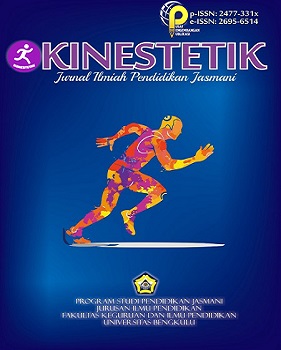Main Article Content
Abstract
The aim is to analyze the two handed backhand motion of the athletes of the Unimed Tennis Community in 2021.The research was carried out at the Medan State University Tennis Court (UNIMED) Jln. William Iskandar Pasar V Medan Estate. Data collection was carried out on October 25, 2021. The number of samples in this study amounted to 3 people. This research is a kind of quantitative approach research (non-experimental) by analyzing the motion of the two-handed backhand technique between athletes who are used as comparisons with international athletes as samples using the Dartfish teampro 5.5 software.The percentage of successful movements analyzed using darfish software Two-handed backhand technique, the position of the prefix movement is Very Good (30%), Good (26.66%), Less (40%), Very Poor (6.66%). The position of the implementation movement is Very Good (14.81%), Good (25.92%), Poor (11.11%), Very Less (48.14%). Position of follow up Very Good (12.5), Good (41.66%), Poor (16.66%), Very Less (29.16%).
Article Details
Copyright (c) 2022 Mahmuddin Mahmuddin, Ade Riana Br. Ginting, Muhammad Faisal Ansari Nasution

This work is licensed under a Creative Commons Attribution-ShareAlike 4.0 International License.
Authors who publish in this journal agree with the following terms:- Authors retain copyright and grant the journal right of first publication with the work simultaneously licensed under a Creative Commons Attribution-ShareAlike 4.0 (CC BY-SA) that allows others to share the work with an acknowledgement of the work's authorship and initial publication in this journal.
- Authors are able to enter into separate, additional contractual arrangements for the non-exclusive distribution of the journal's published version of the work (e.g., post it to an institutional repository or publish it in a book), with an acknowledgement of its initial publication in this journal.
- Authors are permitted and encouraged to post their work online (e.g., in institutional repositories or on their website) prior to and during the submission process, as it can lead to productive exchanges, as well as earlier and greater citation of published work (See The Effect of Open Access).
- This work is licensed under a Creative Commons Attribution-ShareAlike 4.0 International License.
References
- Abdul Alim. (2019). Teknik dan Taktik Bermain Tenis Lapangan.
- Giriwijoyo, D. (2005). Ilmu Faal Olahraga. Bandung: PT Remaja Rosdakarya.
- Hartmann, Doug. and Kwauk, C. (2011). Sport and Development: An Overview, Critique, and Reconstruction. Sport & Socialissues, 284–305.
- ?brahim, C. A. M., Turhan, B., & Zeynep, O. N. A. G. (2013). The analysis of the last shots of the top-level tennis players in open tennis tournaments. Turkish Journal of Sport and Exercise, 15(1), 54–57.
- Jane, E. Ruseski., Brad, R. Humphreys., Kirstin, Hallman., Pamela, W., & Christoph, B. (2014). Sport participation and subjective well being. Journal of Physical Activity and Health, 396–403.
- Jim, B. (2007). Tenis tingkat pemula. Jakarta: PT RajaGrafindo.
- Mundaru. (2006). Olahraga alternatif badminton dan tenis.
- Nurkadri. (2017). Model Latihan Teknik Dasar Tenis Lapangan Untuk Pemain Pemula. Bekasi: Cakrawala Cendekia.
- Palmizal, A. (2011). Pengaruh Metode Latihan Global terhadap Akurasi Groundstroke Forehand dalam Permainan Tenis. Media Ilmu Keolahragaan Indonesia, 1(2). https://doi.org/10.15294/miki.v1i2.2029
- Sudjana. (2002). Metode Statistik. Bandung: Tarsito Bandung.
- Sugiyono. (2013). Metodologi Penelitian Pendidikan. Alfabeta, cv. Bandung: Alfabeta cv.
- Sukadiyanto. (2003). Teori dan metodologi melatih fisik petenis. Yogyakarta?: Fakultas Ilmu Keolahragaan UNY.
- Yasriuddin, & Wahyudin,(2017). Tenis Lapangan Metode Mengajar & Teknik Dasar Bermain. In Yogyakarta: Andi.
- G., Dalam, G., Video, B., Atlet, U., Tennis, J., Arifianto, I. Jatra, R. (2021). Training, Jurnal Mensana. 6, 12–22
- .
- Yudoprasetio. (2002). Belajar Tenis Jilid 2. Jakarta: Bharata Karya Aksara.
References
Abdul Alim. (2019). Teknik dan Taktik Bermain Tenis Lapangan.
Giriwijoyo, D. (2005). Ilmu Faal Olahraga. Bandung: PT Remaja Rosdakarya.
Hartmann, Doug. and Kwauk, C. (2011). Sport and Development: An Overview, Critique, and Reconstruction. Sport & Socialissues, 284–305.
?brahim, C. A. M., Turhan, B., & Zeynep, O. N. A. G. (2013). The analysis of the last shots of the top-level tennis players in open tennis tournaments. Turkish Journal of Sport and Exercise, 15(1), 54–57.
Jane, E. Ruseski., Brad, R. Humphreys., Kirstin, Hallman., Pamela, W., & Christoph, B. (2014). Sport participation and subjective well being. Journal of Physical Activity and Health, 396–403.
Jim, B. (2007). Tenis tingkat pemula. Jakarta: PT RajaGrafindo.
Mundaru. (2006). Olahraga alternatif badminton dan tenis.
Nurkadri. (2017). Model Latihan Teknik Dasar Tenis Lapangan Untuk Pemain Pemula. Bekasi: Cakrawala Cendekia.
Palmizal, A. (2011). Pengaruh Metode Latihan Global terhadap Akurasi Groundstroke Forehand dalam Permainan Tenis. Media Ilmu Keolahragaan Indonesia, 1(2). https://doi.org/10.15294/miki.v1i2.2029
Sudjana. (2002). Metode Statistik. Bandung: Tarsito Bandung.
Sugiyono. (2013). Metodologi Penelitian Pendidikan. Alfabeta, cv. Bandung: Alfabeta cv.
Sukadiyanto. (2003). Teori dan metodologi melatih fisik petenis. Yogyakarta?: Fakultas Ilmu Keolahragaan UNY.
Yasriuddin, & Wahyudin,(2017). Tenis Lapangan Metode Mengajar & Teknik Dasar Bermain. In Yogyakarta: Andi.
G., Dalam, G., Video, B., Atlet, U., Tennis, J., Arifianto, I. Jatra, R. (2021). Training, Jurnal Mensana. 6, 12–22
.
Yudoprasetio. (2002). Belajar Tenis Jilid 2. Jakarta: Bharata Karya Aksara.
